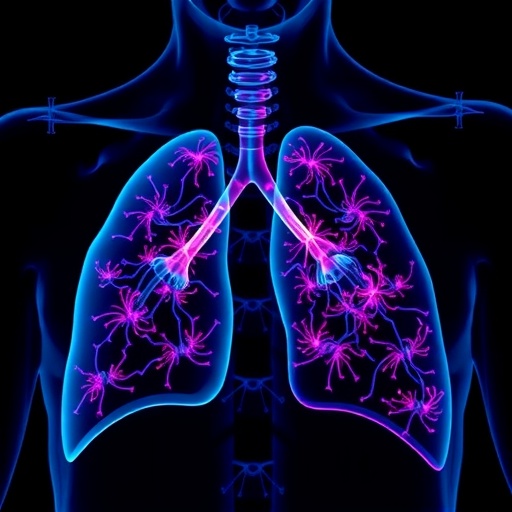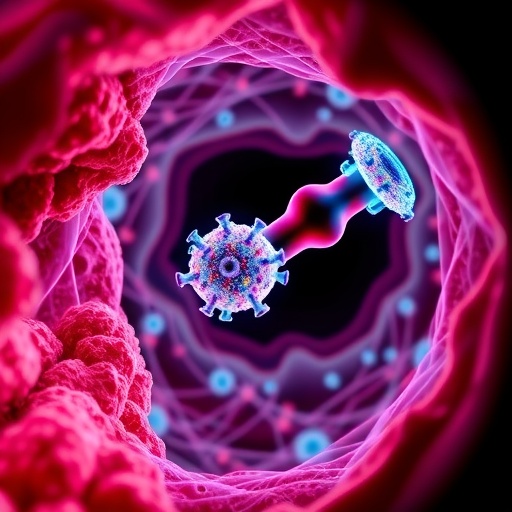In a groundbreaking advance in computational oncology, researchers at Graz University of Technology (TU Graz) have developed an extraordinarily detailed digital twin of the A549 lung cancer cell line, a model that promises to revolutionize our understanding of tumor cell bioelectricity. Led by Christian Baumgartner from the Institute of Health Care Engineering, this pioneering work captures the intricate bioelectric processes and calcium dynamics within cancer cells, offering a new window into how electrical signals and ionic currents drive cancer progression. Unlike previous models, this digital twin simulates intracellular calcium microdomains—tiny but crucial areas where calcium concentration affects cell survival and proliferation—revealing previously hidden pathways that govern cancer cell behavior.
At the heart of this innovation is calcium, a versatile signaling molecule essential for numerous cellular functions. While calcium supports basic cellular vitality, elevated concentrations within the cell can induce apoptosis, or programmed cell death. This dichotomy has made calcium signaling a prime target for cancer therapy, yet the challenge has been to understand the precise spatiotemporal dynamics of calcium distribution inside the cell. The new model addresses this challenge meticulously by incorporating calcium release-activated calcium (CRAC) channels—specialized ion channels situated near microdomains adjacent to the cell membrane. These CRAC channels finely regulate calcium influx, activating intracellular signaling cascades integral to the cell cycle and other vital processes.
The model supersedes an earlier framework from 2021, which was the first to digitize the ion currents in the A549 lung adenocarcinoma line, but failed to capture localized calcium dynamics with the same granularity. Baumgartner’s team now employs a complex system of mathematical equations representing biochemical reactions, ion channel kinetics, buffer capacities, and diffusion processes. This computational model captures the previously elusive storage, release, and transport mechanisms for calcium within various intracellular compartments. By resolving calcium dynamics at the microdomain level, the simulation mirrors the spatial heterogeneity of signaling events, an essential feature for faithful replication of bioelectric phenomena in cancer cells.
The critical advance in simulating the electrical activity of lung adenocarcinoma cells lies in revealing their non-traditional bioelectric behavior. Although not excitable in a neuronal sense, A549 cells exhibit electrical signals modulated by ion channel operation and ionic concentration gradients. The digital twin’s detailed depiction provides unprecedented insight into how voltage changes across the plasma membrane and the localized calcium flux can modulate downstream pathways that influence cellular proliferation, differentiation, or death. Such precise mapping of bioelectric events can illuminate therapeutic windows where drugs might alter ion channel function to interrupt the cancer cell cycle or trigger apoptosis.
One of the most exciting implications of this research is its potential to guide drug discovery through computational experimentation. Traditionally, testing ion channel-modulating compounds involves laborious in vitro assays and animal models, often with inconclusive translation to clinical settings. Using the digital twin, researchers can simulate the impact of candidate drugs on calcium currents, channel conductance, and intracellular signaling without needing immediate biological material. The model can predict whether manipulating CRAC channels or altering calcium buffering might effectively halt cancer cell growth or sensitize cells to other treatments, streamlining the drug development pipeline.
Moreover, the simulation facilitates exploration of complex combinatorial effects—how simultaneous changes across multiple ion channels influence overall cell fate. Such multidimensional testing is prohibitively difficult in wet-lab experiments because of the staggering number of variable combinations. The digital twin, therefore, offers a powerful in silico platform to disentangle the multifaceted biochemical crosstalk underlying cancer cell behavior, providing hypotheses for targeted experiments that may drastically reduce time and cost in researching effective therapies.
Despite its sophistication, the model currently simulates only a single A549 cell, limiting its capacity to explore multicellular phenomena such as tumor growth, metastasis, or angiogenesis. Intercellular communication, which plays a vital role in cancer progression and in the tumor microenvironment’s complexity, awaits incorporation into future iterations. The research team acknowledges this gap and intends to extend the simulation to multi-cell systems, enabling the study of signal propagation between cells and the emergence of collective tumor behaviors.
Looking ahead, the long-term vision includes personalizing these digital twins to reflect patient-specific tumor profiles and cellular heterogeneity. By integrating genomics, proteomics, and clinical data, future models might simulate how individual tumors react to treatments, ushering in an era of precision oncology where computational modeling directly informs patient care. Beyond lung cancer, the methodologies developed here hold promise for application to other malignancies, including breast and prostate cancers, by adjusting the ion channel repertoires and cellular biophysics to cell type-specific parameters.
This work marks a transformative step in oncology research because it bridges computational biophysics with clinical needs, using advanced simulations to bridge the knowledge gap between molecular dynamics and macroscopic tumor behavior. As computational power and biological data integration continue to improve, such digital cell twins could become indispensable tools in discovering new drug targets, designing personalized therapeutic regimens, and ultimately improving patient outcomes.
The DigLungCancer project, funded by the Styrian branch of the Austrian cancer advisory and support organization Österreichische Krebshilfe, exemplifies the increasing convergence of engineering, biology, and medicine. The collaborative team combines expertise in bioengineering, computational modeling, and cancer biology, painting a promising picture of interdisciplinary innovation aimed at tackling one of humanity’s most challenging diseases.
In summary, the creation of this highly detailed, bioelectrically faithful digital twin of the A549 lung cancer cell offers a new paradigm for interrogating the role of calcium dynamics and bioelectric signaling in cancer. By simulating the microenvironment of ion channels and intracellular calcium gradients with unprecedented accuracy, it provides a rich computational framework for exploring novel therapeutic approaches. Future enhancements to incorporate multicellular interaction and patient-specific data could make such models central to personalized cancer treatment strategies, heralding a new age of “virtual testing” that accelerates discovery while reducing reliance on traditional experimental bottlenecks.
Subject of Research: Cells
Article Title: Computational modeling and simulation in oncology
News Publication Date: 5-Sep-2025
Web References: http://dx.doi.org/10.1002/ctm2.70456
Image Credits: Anne Weston, Francis Crick Institute (Licensed under CC BY-NC 4.0)
Keywords: digital twin, lung cancer, A549 cell line, calcium dynamics, bioelectricity, CRAC channels, computational modeling, ion channels, cancer treatment, personalized medicine, oncology simulation
Tags: A549 lung cancer cell lineapoptosis and cancer therapybioelectric processes in cancercalcium dynamics in tumor cellscancer cell bioelectricitycomputational oncology advancementsCRAC channels in cancer cellsdigital twin technologyGraz University of Technology researchintracellular calcium microdomainslung cancer researchspatiotemporal dynamics of calcium





